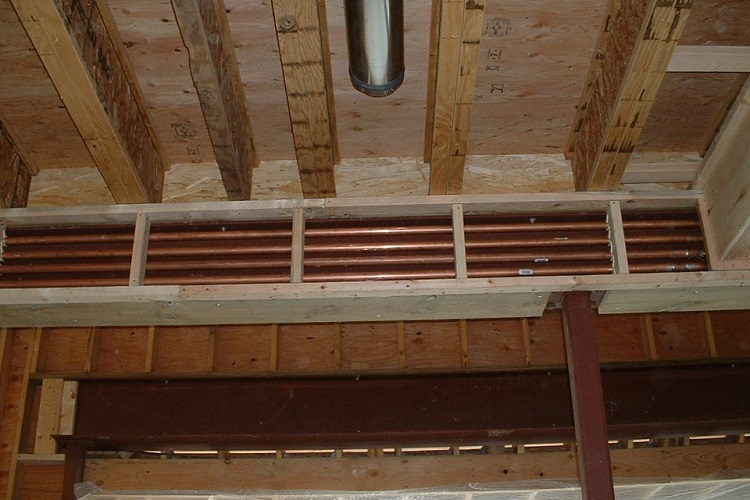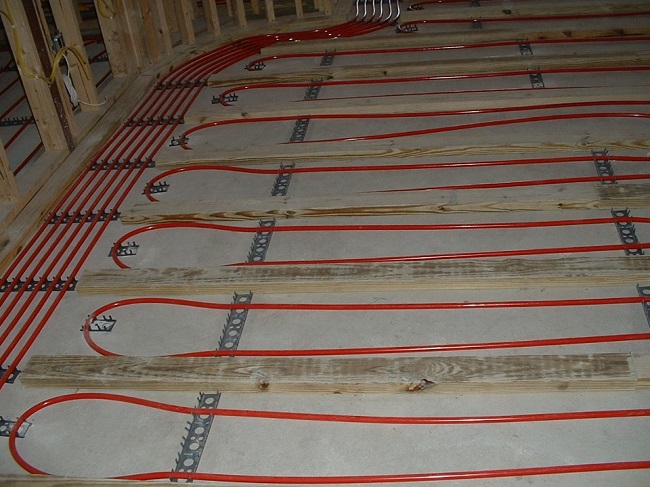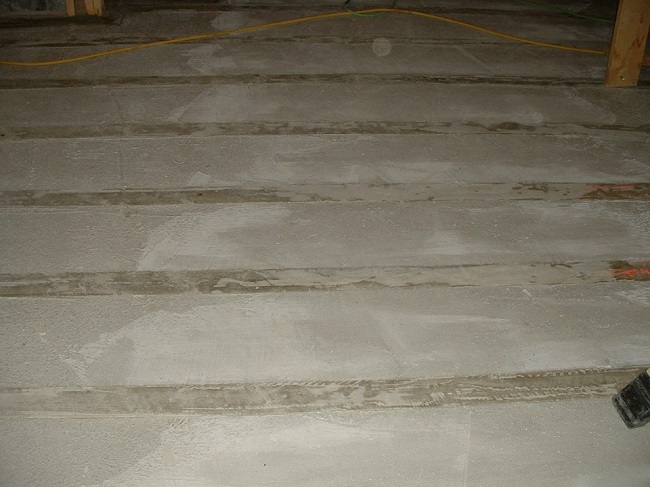
By Gregory Havel
My previous article discussed composite structural components made of concrete and steel, wood and steel, and brick and concrete masonry units (CMU).
Another type of composite that has been used much in the past is a composite of wood and concrete, and it is still in frequent use. This combination can be considered a composite when an assembly of wood joists and subfloor supports a concrete slab, regardless of whether or not it uses an adhesive (bonding agent) or mechanical connections to bind the wood to the concrete. The wood supports the concrete, while the concrete adds strength and rigidity to the floor while reducing sound transmission.
Photo 1 shows, from the bottom-up: a wood column, the wood joist at the edge of the floor, the rotted ends of the tongue-and-groove boards supporting the original concrete floor, the original concrete floor; and the concrete topping that was poured on top of the original when it cracked.
(1) Photos by author.
A modern version of this type of composite includes the plywood or oriented strand board (OSB) deck (photo 2) that supports lightweight concrete (photo 3) in a radiant floor heating panel, all of which is supported by wood I-joists or wood trusses (photo 4).

(2)

(3)

(4)
Wood-concrete composite floors are especially hazardous to emergency responders when there is a fire below the floor, exposing and burning away the structural support for the concrete. According to firefighter fatality reports from the National Institute for Occupational Safety and Health (NIOSH) (https://www.cdc.gov/niosh/fire/default.html), the configuration of the floors that have collapsed and caused firefighter fatalities is very common in construction during the past 20 years; some examples follow:
- Floors supported by wood I-joists or open-web parallel-chord trusses, often exposed in a basement or the cellar below.
- A subfloor deck of plywood or OSB.
- Optional foam insulation board.
- Plastic tubing embedded in 1½ to three inches (3.7 to 7.6 cm) of lightweight concrete with wood nailers.
- Finished floor of underlayment and carpet, hardwood boards, ceramic tile, or other surfaces.
Failure of concrete floors supported by wood during structure fires is not news, since the type of floor shown in photo 1 has caused many firefighter fatalities in older buildings over the past century. This has been the topic of articles in magazines and discussions in fire service textbooks, including the following:
- Francis Brannigan’s Building Construction for the Fire Service, Third Edition, 1992; pages 152 and 336.
- Brannigan’s Fourth Edition; pages 171 and 231.
- Branningan’s Fifth Edition; pages 342-343.
- Vincent Dunn’s Collapse of Burning Buildings, 1988; pages 86-88.
- International Fire Service Training Association/Fire Protection Publications Building Construction Related to the Fire Service, Second Edition, 1999; pages 99 and 101.
- John Norman’s Fire Officer’s Handbook of Tactics, Fourth Edition, 2012; pages 425-428.
- Underwriters Laboratories (UL) Firefighter Safety Research Institute: http://ulfirefightersafety.com
A new type of wood-concrete composite is proposed for mass timber buildings using floor-ceiling panels of cross-laminated timber (CLT). According to the architectural firm of Skidmore, Owings, and Merrill in the article, “In a City of Steel Giants, Can SOM Build a Wood Skyscraper?” in Chicago magazine (http://www.chicagomag.com/city-life/October-2016/SOM-Wood-Skyscraper-CLT), they propose a 42-story building of laminated wood beams and columns and floors of a composite of cross laminated timber panels topped with 1½ inches (3½ cm) of concrete.
The article states that the concrete is needed to stiffen the floor, reduce sound transmission from the floor above, and increase the fire resistance of the floor. Specially designed connectors will be used to make the CLT-concrete panel a true structural composite, rather than concrete supported by wood. The article also states that, “It is wood, and it does burn, but it burns slowly and predictably, and while it burns, it creates an insulating layer, which protects from some of the structural dangers with fire.” The article does not state the amount of charring that the composite CLT-concrete panel can withstand before its safety factor is burned away and the floor becomes likely to collapse.
Based on experience with heavy timber buildings featuring concrete floors supported by wood, the collapse of radiant floor heating panels during structure fires, and the lessons learned from the UL and the National Institute for Standards and Technology fire studies, the fire service must be skeptical of the marketing of wood-built high-rises. For the protection of the public who will occupy these buildings as well as the safety of emergency responders during fires and other unusual incidents during the life of these buildings, the fire service must require that the underside of all CLT panels be protected by fire-rated gypsum drywall board and that these structures be completely protected by National Fire Protection Association 13, Standard for the Installation of Sprinkler Systems, compliant automatic fire sprinkler systems.
Download this article as a PDF HERE (566 KB)
 Gregory Havel is a member of the Town of Burlington (WI) Fire Department; retired deputy chief and training officer; and a 35-year veteran of the fire service. He is a Wisconsin-certified fire instructor II, fire officer II, and fire inspector; an adjunct instructor in fire service programs at Gateway Technical College; and safety director for Scherrer Construction Co., Inc. Havel has a bachelor’s degree from St. Norbert College; has more than 35 years of experience in facilities management and building construction; and has presented classes at FDIC.
Gregory Havel is a member of the Town of Burlington (WI) Fire Department; retired deputy chief and training officer; and a 35-year veteran of the fire service. He is a Wisconsin-certified fire instructor II, fire officer II, and fire inspector; an adjunct instructor in fire service programs at Gateway Technical College; and safety director for Scherrer Construction Co., Inc. Havel has a bachelor’s degree from St. Norbert College; has more than 35 years of experience in facilities management and building construction; and has presented classes at FDIC.
MORE CONSTRUCTION CONCERNS

